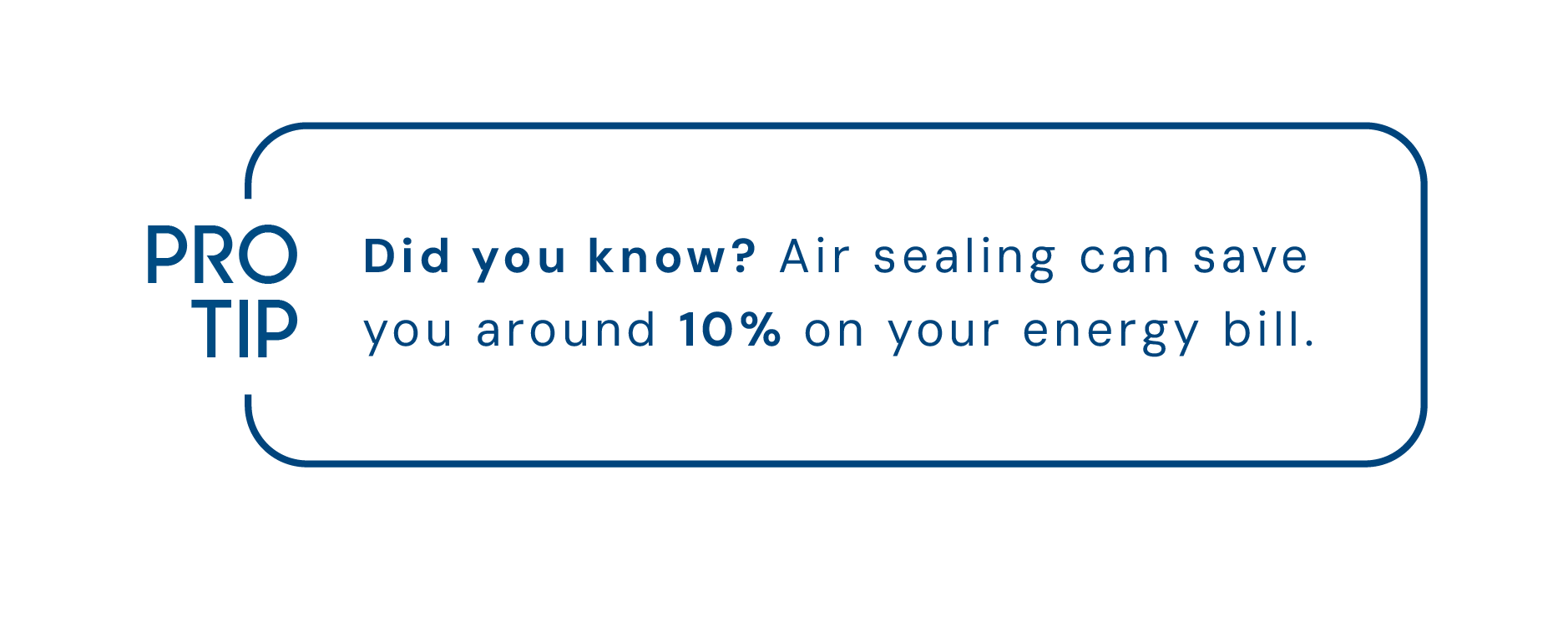House too hot? Keep summer heat out of your home.

A too-hot home can make for a very long summer. But cooling down your home isn’t always as simple as turning down the thermostat. A lot of factors contribute to how efficiently — or inefficiently — your home maintains your preferred temperature. Insulation, ductwork and air sealing can make or break your home’s energy efficiency, leaving you with an energy bill that’ll make you sweat or one that feels more like a breath of fresh air. So, let’s explore how summer heat can enter your home, how it gets trapped inside, and a range of solutions to keep the indoor temps you want within reach.
How heat moves.
Quick science lesson! Heat is transferred in three unique ways: conduction, radiation and convection. You don’t need to understand the principles of heat transfer to know your home is too hot, though. This quick review, however, provides context for why certain efficiency upgrades matter so much to your overall energy bill and comfort. Let’s break them down:
- Conduction is heat transfer through solid material. Think: roof, walls and windows.
- Convection is heat transfer through circulation, or just simply air exchange. Warm air is less dense than cool air, so warm air rises while cool air sinks. Heat always travels from hot to cold.
- Radiation is heat transfer through visible and non-visible light. Think: sunlight or low-wavelength infrared radiation like heat from a hot stovetop burner.
Conduction and convection are the most common means of heat transfer in a home. Radiation only accounts for a small percentage of total heat transfer, and that’s most likely to come almost exclusively from your windows.
How hot air from outside gets inside your home.
Now that we’ve got the basics of heat transfer down, let’s get more specific about how hot air from outside actually gets inside your home. Any opening in your home, whether that’s a fully open door or a teeny, tiny space around an outside dryer vent, is an invitation for air exchange.
So, for instance, let’s say you leave your screen door open in the summer while your AC is running. (Of course, we definitely don’t recommend this.) The hot summer air, like a moth to a flame, will beeline it straight inside your home as it moves toward and mixes with your cool air. The reverse is true in the winter. All the lovely warm air inside your home will escape through any gap or crack possible as it draws itself toward cooler air. Remember, heat always moves from hot to cold.
Insulation: Your home’s blanket.
Insulation’s singular purpose is to be an obstacle for heat, whether that’s stopping outside hot air from coming in or preventing your indoor heat from going out. But insulation, hidden behind walls, under floors and in the attic, tends to fall into the category of Out of Sight, Out of Mind. So, we’re here to bring it back to the top of your mind!
The most powerful, energy efficient HVAC system in the world will never be able to live up to its full potential if your home’s insulation doesn’t pull its own weight. You can blast your AC as low as it can go all day long, but a poorly insulated home will be no match for outside heat determined to get inside.

The 3 main reasons why you should upgrade your insulation.
- Lowers your energy bill.
- Increases your indoor comfort.
- Extends the life of your HVAC system.
Plus, you can combine our home energy rebates on insulation with federal tax credits to increase your total savings.
Duct system: Your home’s highway.
Your home’s duct system works hand-in-hand with your heating, cooling, air conditioning and ventilation (HVAC) system. An HVAC system creates the heating or cooling necessary to get your home to its desired temperature while your duct system is responsible for actually moving that warm or cool air around your home. The HVAC and duct systems also work together to maintain indoor air quality, regulating temperature and humidity while also removing pollutants from the air you breathe inside your home. Your duct system has a big job, so ensuring that it operates at peak efficiency is a priority.

How to tell if your duct work needs maintenance.
For the most part, your home’s duct work won’t be visible to you. But just because you can’t see a crack or feel a leak doesn’t mean your home won’t give you some helpful signs that some maintenance needs to be done. Be on the lookout for:
- Higher than normal energy bills.
- Difficulty maintaining your desired temperature.
- Uneven heating and cooling.
- Noticeable dustiness.
- Whistling or whooshing sounds when your HVAC runs.
- Dirt, dust, mold or condensation around air vents.
The 4 main reasons why you should seal and insulate your duct system.
You can lose 20-40% of your heating and cooling through air leaks and poor duct insulation. Sealing, insulating or replacing ductwork comes with a number of benefits. These simple fixes can:
- Lower your energy bill.
- Protect the air you breathe.
- Increase your indoor comfort.
- Put less wear and tear on your HVAC system.
Plus, TVA EnergyRight offers a $300 rebate on duct system upgrades so that you can enjoy a more energy efficient home at an affordable price.
Air sealing: Your home’s bouncer.
OK, so now that your home’s blanket (insulation) and highway (duct system) are firing on all cylinders, there’s one piece left to round out this efficiency trifecta: air sealing. Air sealing, also sometimes referred to as weatherization, is the process of identifying and sealing any gaps or cracks inside your home or in your home’s exterior where air can sneak in or out. It’s like your home’s very own bouncer, one that blocks the riff raff (outside air and pollutants) from entering so that all the people inside can continue to have a good time!
Sealing these air leaks might seem like an insignificant task, but it’s actually a really important step for improving your home’s overall energy efficiency. Not only does it keep outside air out, but it’s also going to allow your insulation, duct system and HVAC system to all operate more efficiently, increasing their lifespans.

How to tell if your home needs to be air sealed.
It’s a safe bet that pretty much all homes (even brand new builds) could benefit from air sealing. The goal isn’t to have a completely airtight home, but rather to control how air enters and exits your home and to block out pollutants, odors and unwanted outside air. And while there are many places where air sealing seems obvious, like around doors and windows, there are many more where you might not ever think to look. Here’s what to look for:
- Visible daylight around doors or windows.
- Visible gaps or cracks around plumbing fixtures and electrical wires.
- Drafty rooms or cold spots.
- Difficulty maintaining your desired temperature.
- Higher than normal energy bills.
The most common places around your home for air leaks.
The trick to mastering air sealing is to focus on the nooks and crannies of your home. A lot of air leaks can be stopped simply with the use of some weatherstripping or caulk. Other more hard-to-see spots could require a professional. Here are the areas of your home most likely to experience air leaks:
- Around doors and windows.
- Around pipes and drains.
- Around electrical sockets and light switches.
- Around recessed lighting.
- Floorboards and floor vents.
- Floors, ceilings and walls.
- Crawl spaces, attics and basements.
- Unheated garages.
The 3 main reasons why you should air seal your home.
- Lowers your energy bill.
- Increases your indoor comfort.
- Blocks outside pollutants.
- Improves the functionality of your insulation, duct system and HVAC system.
Plus, you can combine our home energy rebate on air sealing with federal tax credits to increase your total savings.
DIY weatherization
Some spots are easier to air seal than others. Take a stab at DIY weatherization with a few simple air sealing tools, like weatherstripping, door sweeps, caulk, a caulk gun, and some spray foam. Check out our weatherproofing video to get started!

Try these 7 free DIY heat-blocking solutions.
Speaking of DIY tips, here are seven totally free actions you can take to keep your home cooler all summer long.
1. Bump up your thermostat a few degrees when you’re home.
For every degree you set your thermostat above 72° F you can save up to 3% on your energy bill. And if you plan to be away for six or more hours, shoot for 78° F. Just remember, when you’re ready to cool the house back down, only set it to your desired temperature. Dropping the temperature as low as it can go doesn’t make your AC work faster, but it will make your system work harder for longer.
2. Uncover, open and clean air vents.
Contrary to popular belief, closing vents in one room to drive more cool air to another doesn’t work. Closing vents or covering them with rugs or furniture makes your HVAC system work harder and can damage the compressor.
3. Shut doors and windows.
It sounds too simple, but the best way to keep hot air outside is by shutting doors and windows. Running the AC with even one door or window cracked is like letting money fly right out of that open window.
4. Keep blinds and curtains closed.
You don’t need to turn your house into a dungeon, but it’s definitely worth it to strategically open and close curtains and blinds. During the hottest parts of the day or in the sunniest areas of the home, keep blinds and curtains closed. If you’ll be gone all day, close everything up.
5. Set ceiling fans to spin counterclockwise.
Take 15 seconds to set your ceiling fans to rotate counterclockwise, creating a cooling downdraft. Remember, though, ceiling fans cool people, not rooms. Empty rooms don’t need running fans.
6. Take the free DIY Home Energy Assessment.
Take our free online DIY Home Energy Assessment and learn how your home uses (and loses) energy. When you’re done, you’ll get an easy-to-follow report highlighting the exact steps you can take to boost your home’s energy efficiency and start saving money! You’ll also get these great freebies:
- Free access to our Quality Contractor Network.
- Free energy-saving kit.
- Free $10 home improvement store gift card.
Prefer a pro? Book a Home Energy Evaluation with a TVA-certified Home Energy Advisor instead.
7. Beat the heat and download the Keep It Cool Summer Checklist.
Download our Keep It Cool Summer Checklist and see how many items you can complete. Plus, you can get even more heat-blocking tips here.
Hire a TVA-vetted contractor and get insulation, duct system and air sealing rebates.
The more energy efficient your home is, the more manageable your energy bills become. To help you reach better energy efficiency sooner, TVA EnergyRight offers a range of money-saving home energy rebates. Getting started is easy. Just head to our Quality Contractor Network to find a TVA-vetted contractor in your area, and they’ll connect you with the right energy upgrades and rebates for your home. Then sit back, relax and enjoy a lower energy bill and a more comfortable home.
Find a contractor and get your home energy rebates today.




